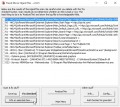An unwanted web page appeared on your browser instead of Google? Or, you are faced with the fact that your browser is now redirected from Google to other intrusive web-pages and filled with multiple ads and banners. The cause of all your problems with your system is ‘ad-supported’ software (also known as adware) that has been installed on many PCs around the world without users permission, so you’re one of many. Most probably, you do not even know how and where this adware has got into your PC system. In the few simple steps below, we will explain all the general features of ad-supported software and its typical behavior on the PC system, as well as effective methods for manually removing it from your system.
The adware is not a virus, but the virus behaves similarly. As a rootkit hides in the system, modifies web-browser settings and blocks them from changing. Also the ad-supported software can install additional internet browser extensions and modules that will inject advertisements within the Chrome, Firefox, Edge and Internet Explorer’s screen. Moreover, the ad-supported software may install web-browser hijacker that once started, will change the web browser’s startpage and search engine. And finally, the ‘ad supported’ software can collect a wide variety of personal information such as what sites you are opening, what you are looking for the Internet and so on. This information, in the future, may be transferred to third parties.
In addition to that, as was mentioned earlier, certain ‘ad supported’ software to also alter all browsers shortcuts which located on your Desktop or Start menu. So, every infected shortcut will try to redirect your web-browser from Google to unwanted web pages, some of which might be harmful. It can make the whole computer more vulnerable to hacker attacks.
Thus, it is clear that the presence of ad-supported software on your personal computer is not desirable, and you need to clean up your PC system ASAP. Follow the step-by-step guide below in order to remove Google redirect.
Table of contents
- Google redirect removal guide
- Remove Google redirect without any tools
- Removing the Google redirect, check the list of installed software first
- Fix infected web-browsers shortcuts to delete Google redirect
- Delete Google redirect from Mozilla Firefox by resetting internet browser settings
- Remove Google redirect from Google Chrome
- Delete Google redirect from Internet Explorer
- Get rid of unwanted Scheduled Tasks
- Google redirect removal tools
- Remove Google redirect without any tools
- Use AdBlocker to stop Google redirect and stay safe online
- How does your computer get infected with Google redirect adware
- Finish words
Google redirect removal guide
Without a doubt, the ad supported software is harmful to your PC system. So you need to quickly and completely remove this adware which developed to redirect your web-browser from Google to various ad web-sites. In order to get rid of this ad-supported software, you can use the manual removal tutorial that are given below or free malware removal tool such as Zemana Anti-malware, Malwarebytes or AdwCleaner (all are free). We recommend you use automatic removal way that will help you to remove Google redirect easily and safely. Manual removal is best used only if you are well versed in computer or in the case where ad-supported software is not removed automatically. Some of the steps will require you to reboot your machine or exit the web site. So, read this instructions carefully, then bookmark or print it for later reference.
Remove Google redirect without any tools
The useful removal guide for the Google redirect. The detailed procedure can be followed by anyone as it really does take you step-by-step. If you follow this process to get rid of Google redirect adware let us know how you managed by sending us your comments please.
Removing the Google redirect, check the list of installed software first
It is of primary importance to first identify and remove all PUPs, ad-supported software programs and hijackers through ‘Add/Remove Programs’ (Windows XP) or ‘Uninstall a program’ (Windows 10, 8, 7) section of your Microsoft Windows Control Panel.
Windows 8, 8.1, 10
First, click the Windows button
Windows XP, Vista, 7
First, click “Start” and select “Control Panel”.
It will display the Windows Control Panel as shown in the figure below.

Next, click “Uninstall a program” ![]()
It will open a list of all applications installed on your computer. Scroll through the all list, and remove any suspicious and unknown software. To quickly find the latest installed programs, we recommend sort applications by date in the Control panel.
Fix infected web-browsers shortcuts to delete Google redirect
After installed, this adware may add an argument similar “http://site.address” into the Target property of the desktop shortcut for the Mozilla Firefox, Chrome, Internet Explorer and Microsoft Edge. Due to this, every time you start the web browser, it will display an undesired web-page, instead of Google.
Right click to a desktop shortcut for your web browser. Choose the “Properties” option. It will open the Properties window. Select the “Shortcut” tab here, after that, look at the “Target” field. The adware can change it. If you are seeing something such as “…exe http://site.address” then you need to remove “http…” and leave only, depending on the web-browser you are using:
- Google Chrome: chrome.exe
- Opera: opera.exe
- Firefox: firefox.exe
- Internet Explorer: iexplore.exe
Look at the example as shown below.

Once is complete, press the “OK” button to save the changes. Please repeat this step for web-browser shortcuts which redirects to an unwanted sites. When you have completed, go to next step.
Delete Google redirect from Mozilla Firefox
If your FF browser is rerouted from Google to an unwanted web site without your permission or an unknown search engine replaces the Google and opens results for your search, then it may be time to perform the internet browser reset.
Run the Firefox and press the menu button (it looks like three stacked lines) at the top right of the internet browser screen. Next, click the question-mark icon at the bottom of the drop-down menu. It will show the slide-out menu.

Select the “Troubleshooting information”. If you are unable to access the Help menu, then type “about:support” in your address bar and press Enter. It bring up the “Troubleshooting Information” page as shown below.

Click the “Refresh Firefox” button at the top right of the Troubleshooting Information page. Select “Refresh Firefox” in the confirmation dialog box. The Firefox will start a procedure to fix your problems that caused by the adware. When, it is finished, click the “Finish” button.
Remove Google redirect from Google Chrome
Reset Chrome settings is a simple way to delete the browser hijackers, malicious and ‘ad-supported’ extensions, as well as to restore the web-browser’s newtab page, startpage and search provider by default that have been changed by adware.

- First launch the Chrome and click Menu button (small button in the form of three horizontal stripes).
- It will open the Chrome main menu. Select “Settings” option.
- You will see the Google Chrome’s settings page. Scroll down and click “Show advanced settings” link.
- Scroll down again and click the “Reset settings” button.
- The Google Chrome will show the reset profile settings page as shown on the screen above.
- Next press the “Reset” button.
- Once this task is done, your web browser’s home page, new tab and search provider by default will be restored to their original defaults.
- To learn more, read the article How to reset Google Chrome settings to default.
Delete Google redirect from Internet Explorer
The Internet Explorer reset is great if your internet browser is hijacked or you have unwanted addo-ons or toolbars on your web-browser, that installed by an malicious software.
First, launch the Internet Explorer. Next, click the button in the form of gear (![]() ). It will show the Tools drop-down menu, click the “Internet Options” as on the image below.
). It will show the Tools drop-down menu, click the “Internet Options” as on the image below.

In the “Internet Options” window click on the Advanced tab, then click the Reset button. The Microsoft Internet Explorer will open the “Reset Internet Explorer settings” window like below. Select the “Delete personal settings” check box, then press “Reset” button.

You will now need to reboot your system for the changes to take effect.
Get rid of unwanted Scheduled Tasks
If an annoying web-page opens automatically on Windows startup or at equal time intervals, then you need to check the Task Scheduler Library and remove all the tasks which have been created by unwanted programs.
Press Windows and R keys on the keyboard together. This shows a prompt that titled with Run. In the text field, type “taskschd.msc” (without the quotes) and press OK. Task Scheduler window opens. In the left-hand side, press “Task Scheduler Library”, as shown in the figure below.
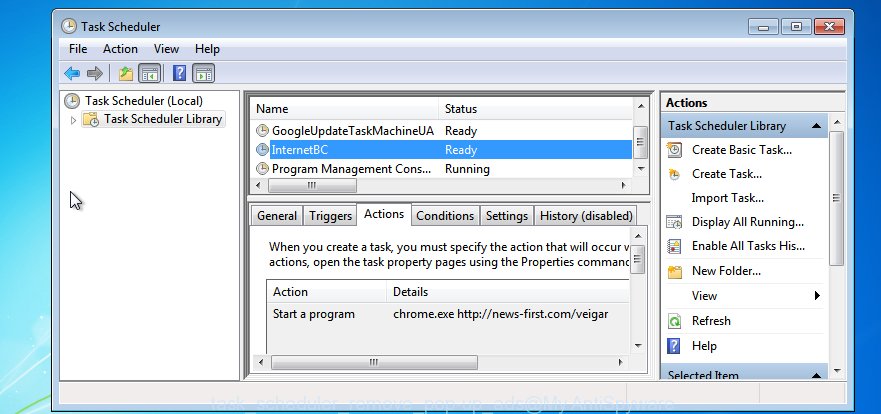
Task scheduler
In the middle part you will see a list of installed tasks. Please select the first task, its properties will be show just below automatically. Next, click the Actions tab. Pay attention to that it launches on your computer. Found something like “explorer.exe http://site.address” or “chrome.exe http://site.address”, then get rid of this malicious task. If you are not sure that executes the task, check it through a search engine. If it is a component of the malicious program, then this task also should be removed.
Having defined the task that you want to remove, then click on it with the right mouse button and choose Delete like below.

Delete a task
Repeat this step, if you have found a few tasks which have been created by malicious programs. Once is finished, close the Task Scheduler window.
Google redirect removal tools
If your computer is still infected with adware that causes multiple annoying pop ups, then the best way of detection and removal is to run an anti-malware scan on the machine. Download free malware removal tools below and start a full system scan. It will allow you delete all components of the adware from hardisk and Windows registry.
Get rid of Google redirect with Zemana Anti-malware
Zemana Anti-malware highly recommended, because it can scan for security threats such adware and ad-supported softwares that most ‘classic’ antivirus software fail to pick up on. Moreover, if you have any Google redirect removal problems which cannot be fixed by this tool automatically, then Zemana Anti-malware provides 24X7 online assistance from the highly experienced support staff.

- Download Zemana anti malware (ZAM) by clicking on the link below.
Zemana AntiMalware
164732 downloads
Author: Zemana Ltd
Category: Security tools
Update: July 16, 2019
- When the download is complete, close all applications and windows on your PC. Open a file location. Double-click on the icon that’s named Zemana.AntiMalware.Setup.
- Further, press Next button and follow the prompts.
- Once installation is complete, click the “Scan” button for scanning your computer for the ad-supported software that developed to redirect your browser from Google to various ad web pages. This process can take some time, so please be patient. While the utility is checking, you can see count of objects it has identified either as being malicious software.
- As the scanning ends, it’ll open you the results. Review the scan results and then click “Next”. When the cleaning process is complete, you may be prompted to restart your PC.
How to automatically remove Google redirect with Malwarebytes
Remove Google redirect manually is difficult and often the adware is not completely removed. Therefore, we recommend you to use the Malwarebytes Free that are completely clean your PC. Moreover, the free program will allow you to get rid of malware, PUPs, toolbars and hijacker infections that your computer may be infected too.
Download Malwarebytes on your PC system from the link below. Save it on your Windows desktop or in any other place.
327003 downloads
Author: Malwarebytes
Category: Security tools
Update: April 15, 2020
When downloading is done, close all software and windows on your system. Double-click the set up file called mb3-setup. If the “User Account Control” dialog box pops up as on the image below, click the “Yes” button.

It will open the “Setup wizard” that will help you set up Malwarebytes on your PC system. Follow the prompts and don’t make any changes to default settings.

Once install is finished successfully, press Finish button. Malwarebytes will automatically start and you can see its main screen as shown below.
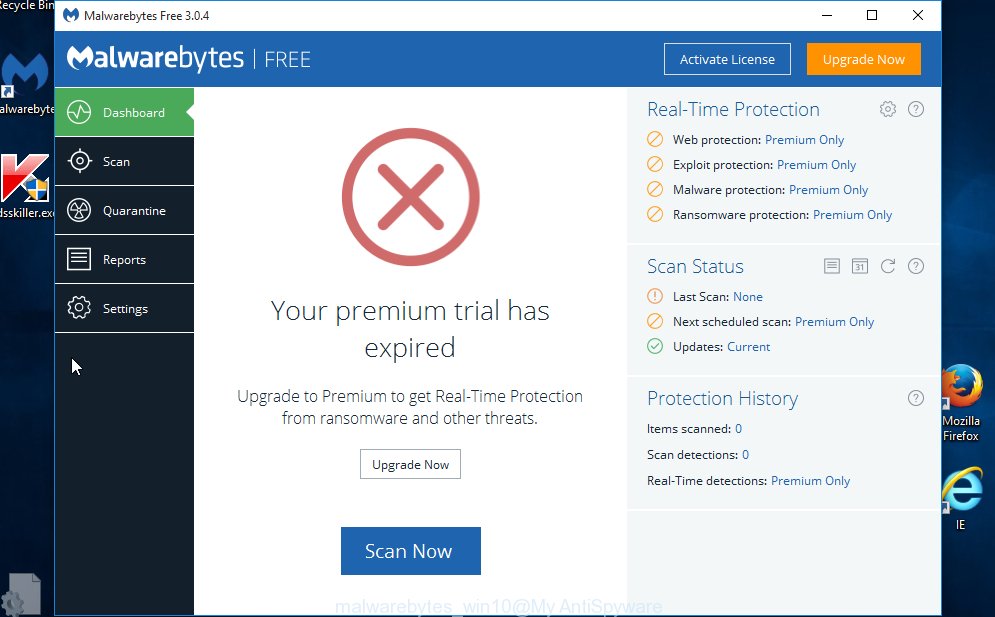
Now click the “Scan Now” button for scanning your machine for the adware. This process may take some time, so please be patient. When a threat is found, the count of the security threats will change accordingly. Wait until the the scanning is finished.
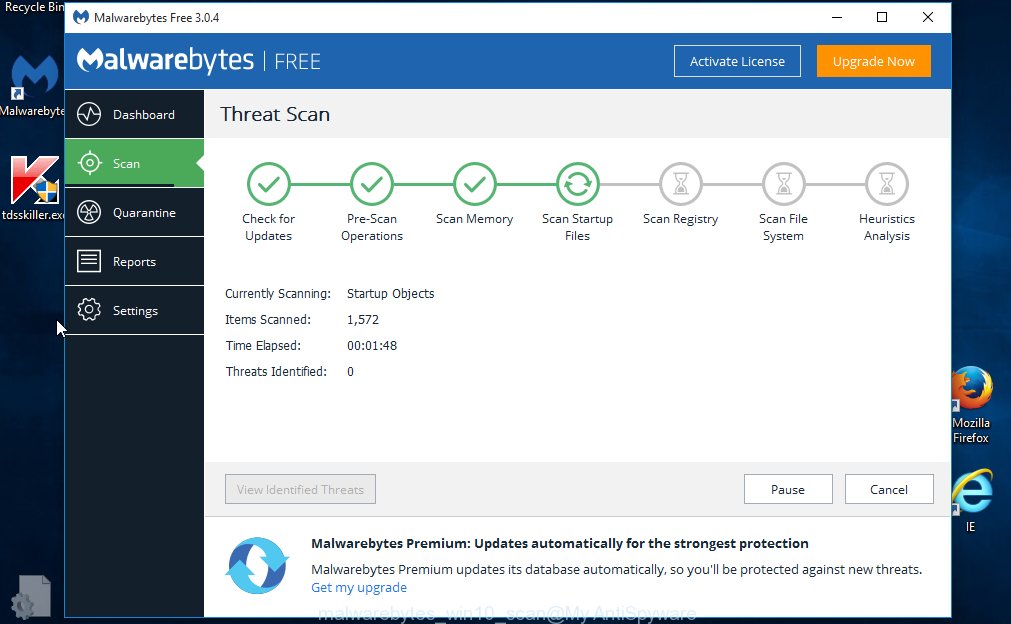
When the system scan is finished, it will open a list of found threats. In order to delete all threats, simply press “Quarantine Selected” button. The Malwarebytes will remove adware which redirects your web browser from Google to unwanted pages. Once the clean-up is done, you may be prompted to restart the PC.
We recommend you look at the following video, which completely explains the process of using the Malwarebytes to remove adware, hijacker and other malicious software.
Run AdwCleaner to delete Google redirect from web browser
AdwCleaner is a free portable program that scans your personal computer for ‘ad supported’ softwarer, potentially unwanted programs and hijackers and allows get rid of them easily. Moreover, it will also help you remove any malicious web-browser extensions and add-ons.
Download AdwCleaner tool by clicking on the link below. Save it to your Desktop so that you can access the file easily.
225513 downloads
Version: 8.4.1
Author: Xplode, MalwareBytes
Category: Security tools
Update: October 5, 2024
Once downloading is finished, open the file location and double-click the AdwCleaner icon. It will launch the AdwCleaner utility and you will see a screen like below. If the User Account Control dialog box will ask you want to display the program, click Yes button to continue.

Next, click “Scan” to perform a system scan for the adware which made to reroute your web browser from Google to various ad sites. Depending on your machine, the scan can take anywhere from a few minutes to close to an hour. While the tool is scanning, you can see number of objects and files has already scanned.

Once it has finished scanning is done, it will display a list of found items as shown on the image below.
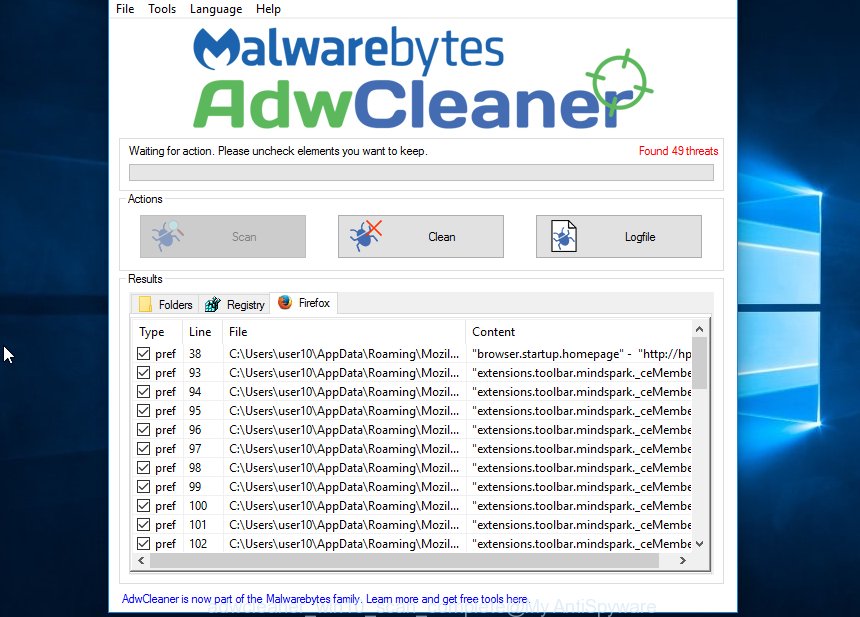
Make sure all items have ‘checkmark’ and click “Clean” button. It will open a prompt. Click “OK” button. The AdwCleaner will remove adware and move threats to the program’s quarantine. Once that process is complete, the tool may ask you to reboot your system. After reboot, the AdwCleaner will display the log file.
All the above steps are shown in detail in the following video instructions.
Use AdBlocker to stop Google redirect and stay safe online
It is important to use ad-blocking programs such as AdGuard to protect your computer from harmful pages. Most security experts says that it’s okay to stop ads. You should do so just to stay safe! And, of course, the AdGuard may to stop a redirect from Google to other intrusive web-sites.
Download AdGuard program from the following link.
26826 downloads
Version: 6.4
Author: © Adguard
Category: Security tools
Update: November 15, 2018
Once downloading is finished, start the downloaded file. You will see the “Setup Wizard” screen as on the image below.

Follow the prompts. Once the install is finished, you will see a window as shown on the image below.

You can press “Skip” to close the installation program and use the default settings, or click “Get Started” button to see an quick tutorial which will help you get to know AdGuard better.
In most cases, the default settings are enough and you do not need to change anything. Each time, when you run your personal computer, AdGuard will start automatically and stop pop ups, Google redirects, as well as other malicious or misleading web-sites. For an overview of all the features of the application, or to change its settings you can simply double-click on the AdGuard icon, that is located on your desktop.
How does your computer get infected with Google redirect adware
Many adware are included in the free programs install package. Most commonly, a user have a chance to disable all included “offers”, but some setup files are made to confuse the average users, in order to trick them into installing the ad-supported software. Anyway, easier to prevent the ‘ad supported’ software rather than clean up your system after one. So, keep the web browser updated (turn on automatic updates), use a good antivirus applications, double check a freeware before you start it (do a google search, scan a downloaded file with VirusTotal), avoid malicious and unknown pages.
Finish words
After completing the step-by-step tutorial outlined above, your computer should be clean from malicious software, hijackers and adware. The Google Chrome, Microsoft Internet Explorer, Firefox and MS Edge will no longer redirect you from Google to other unwanted web sites. Unfortunately, if the steps does not help you, then you have caught a new adware, and then the best way – ask for help.
- Download HijackThis by clicking on the link below and save it to your Desktop.
HijackThis download
4868 downloads
Version: 2.0.5
Author: OpenSource
Category: Security tools
Update: November 7, 2015
- Double-click on the HijackThis icon. Next click “Do a system scan only” button.
- After it has completed scanning, the scan button will read “Save log”, press it. Save this log to your desktop.
- Create a Myantispyware account here. Once you’ve registered, check your e-mail for a confirmation link, and confirm your account. After that, login.
- Copy and paste the contents of the HijackThis log into your post. If you are posting for the first time, please start a new thread by using the “New Topic” button in the Spyware Removal forum. When posting your HJT log, try to give us some details about your problems, so we can try to help you more accurately.
- Wait for one of our trained “Security Team” or Site Administrator to provide you with knowledgeable assistance tailored to your problem with the unwanted Google redirects.



